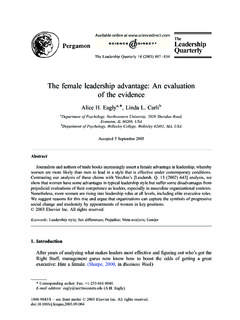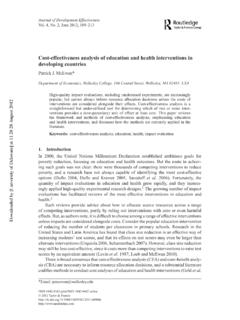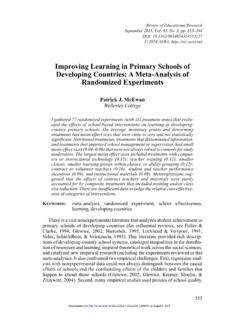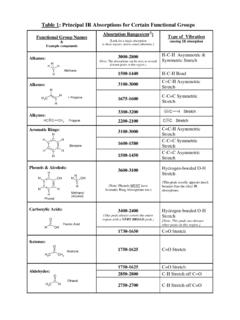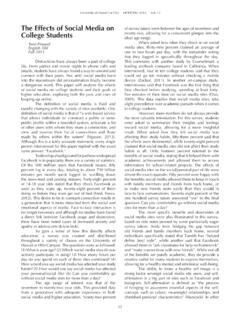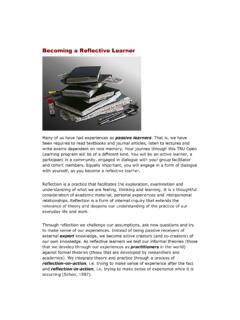Transcription of Gender and Social Influence - Wellesley College
1 Gender and Social InfluenceLinda L. Carli* Wellesley CollegeThis review article reveals that men are generally more influential than women,although the Gender difference depends on several moderators. Relative to men,women are particularly less influential when using dominant forms of communica-tion, whereas the male advantage in Influence is reduced in domains that are tradi-tionally associated with the female role and in group settings in which more thanone woman or girl is present. Males in particular resist Influence by women andgirls more than females do, especially when Influence agents employ highly com-petent styles of communication. Resistance to competent women can be reduced,however, when women temper their competence with displays of communality , most research on Gender and Social Influence has focused ongender differences in influenceability, the extent to which men and women areinfluenced by others.
2 In fact, the numerous studies on this topic have beenreviewed several times ( , Becker, 1986; Eagly, 1978; Eagly & Carli, 1981).Less attention, however, has been devoted to the effect of a person s Gender on hisor her ability to Influence others, an ability that can contribute to effective manage-ment in organizations and is associated with career advancement and increases insalary (Dreher, Dougherty, & Whitely, 1989; Kanter, 1977; Rao, Schmidt, &Murray, 1995). Consequently, examining the factors that contribute to Gender dif-ferences in Social Influence has implications for understanding women s leader-ship. This article reviews research on Gender differences in exerting Influence ,including the factors that moderate the Gender most settings, women possess lower levels of status and power than men do,particularly power based on expertise or legitimate authority (Carli, 1999; Ridge-way, this issue).
3 Because men and women typically fill different roles, with women*Correspondence concerning this article should be addressed to Linda Carli, Department ofPsychology, Wellesley College , Wellesley , MA 02481 [email: 2001 The Society for the Psychological Study of Social IssuesJournal of Social Issues, Vol. 57, No. 4, 2001, pp. 725 741more often occupying caretaking, domestic, and lower status occupational rolesand men more often occupying higher status occupational roles, people expect mento behave more agentically than women and women to behave more communallythan men (Eagly & Johannesen-Schmidt, this issue). Moreover, the prescriptivenature of stereotypes about men and women leads to greater scrutiny of women sthan men s leadership behaviors and to penalties against women whose behavior istoo status asserting or insufficiently communal (Heilman, this issue).]
4 Conse-quently, people assume that men are more competent and knowledgeable thanwomen are, that women are warmer and more communal than men are, that menhave more right to act as authorities than women do, and that women must commu-nicate communal motivation more than men. As a result, not only would peoplegenerally be more open to the Influence of men than that of women, but women sinfluence would be more conditional than men s, dependent on the use of an influ-ence style that corresponds prescriptively to the stereotypical female role. Finally,given that the Gender difference in Influence depends on the relative power ofinteractants, conditions that favor female authority and expertise should reduce thedifference, whereas conditions that highlight Gender as a status characteristicshould increase Differences in Exerting InfluenceNumerous studies have examined Gender differences in exerting Social influ-ence, and most of these, with a few exceptions (Chaiken, 1979; Schneider,1997/1998), have reported Gender differences.
5 A meta-analytic review of theresults of 29 studies revealed that, in mixed-sex groups, men exert more influencethan women (Lockheed, 1985). Other more recent research not included in thereview has confirmed this finding (DiBerardinis, Ramage, & Levitt, 1984; Propp,1995; Schneider & Cook, 1995; Wagner, Ford, & Ford, 1986; Ward, Seccombe,Bendel, & Carter, 1985). Research on children has likewise revealed that boysexert greater Influence than girls (Dion & Stein, 1978; Lockheed, Harris, &Nemceff, 1983; Jacklin & Maccoby, 1978). In general, Influence attempts bywomen and girls are more likely to be ignored than attempts by men and boys, andin group interactions, contributions by men receive more attention from othergroup members and have a greater effect on group members decisions than thesame contributions by women (Altemeyer & Jones, 1974; Jacklin & Maccoby,1978; Propp, 1995).
6 Although evidence clearly demonstrates that women are less influential thanmen, the Gender difference in Influence depends on the context of the interactionand the behavior displayed by the Influence agent. In particular, the Gender compo-sition of the individuals in an interaction; the Influence agents competence, domi-nance, and communality; and the Gender -typing of the task all moderate genderdifferences in Social Moderating Gender Differences in InfluenceGender Composition EffectsGender of recipient of Influence to expectation statestheory (Ridgeway, this issue), Gender effects on Influence depend on the salience ofgender as a status characteristic. Women s lower status relative to men is particu-larly highlighted in interactions between men and women.
7 Consequently, women srelative disadvantage in influencing others would likely be greatest in their inter-actions with men. Moreover, male resistance to female Influence is undoubtedlyone way in which men can maintain their power advantage over women. A reason-able prediction, therefore, is that men may display more resistance to female influ-ence than women would. Of course, depending upon the salience of Gender as astatus characteristic, the particular context of the interaction, the communicationstyle used by the Influence agents (which will be discussed below), and the power ofthe research design, not all studies would be expected to reveal Gender differences inreactions to female Influence agents.
8 Indeed, some studies have shown no signifi-cant interactions between the Gender of the participant and the Gender of the influ-ence agent on Social Influence (Atkinson & Schwartz, 1984; Burgoon, Dillard, &Doran, 1983; Burgoon, Jones, & Stewart, 1975; Williams, 1983/1984). Neverthe-less, when Gender -of-subject effects are found, with rare exceptions (Ward et al.,1985), they reveal that men resist female Influence more than women one study, participants listened to an audiotape of a male or female expertwho presented a speech advocating nontraditional Gender roles; results revealedthat women were equally persuaded by male and female experts, but men were lesspersuaded by a woman than by a man (Rhoades, 1979/1981).
9 Other experimentalresearch on adults confirms that, with a male audience, women exert less influencethan men do (Ridgeway, 1981).Research on children has revealed similar findings. In a study of middle schoolchildren, boys and girls attempted to persuade their peers to eat bitter-tasting crack-ers (Dion & Stein, 1978). Although attractive children were more influential withthe opposite sex than unattractive children, in general, boys were more inclined toeat the crackers after being persuaded by a male than female peer, whereas girlswere equally influenced by both genders. Among 33-month-old toddlers, girlsexerted less Influence over their male playmates than boys did and less influenceover male than female playmates, whereas boys exerted equal Influence regardlessof the Gender of their peers (Jacklin & Maccoby, 1978).
10 Serbin and her colleagues(Serbin, Sprafkin, Elman, & Doyle, 1982) observed 3- to 5-year-old preschoolersduring play to determine whether the children s use of direct requests would be aneffective form of Influence . Results revealed that boys were equally successful ininfluencing male and female peers, but girls were less effective at influencing boysthan girls. Finally, boys resistance to female Influence also extends to their ownGender and Social Influence727mothers. Power and his colleagues (Power, McGrath, Hughes, & Manire, 1994)examined 2- to 6-year-old children s reactions to the Influence attempts of theirparents and found that whereas girls show equal compliance with the requests ofboth of their parents, boys comply more with the requests of their fathers than thoseof their of males and females in an exert greater influ-ence than women and resist women s Influence more than women do because ofthe greater power that men possess in group interactions.
